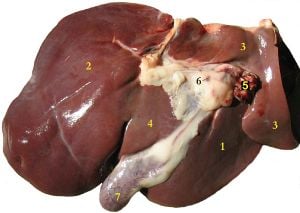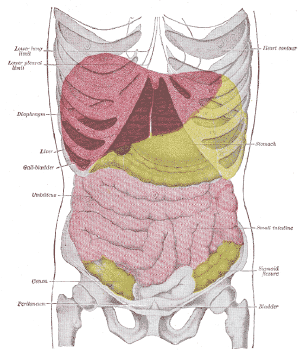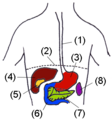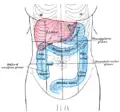Difference between revisions of "Liver" - New World Encyclopedia
| Line 4: | Line 4: | ||
The '''liver''' is a large [[vertebrate]] [[organ]] positioned in the upper region of the abdominal cavity, below the diaphragm. Since most compounds absorbed by the intestine pass through the liver, it functions as a control center that integrates various metabolic processes, regulating the traffic of fuel molecules (e.g., carbohydrates, fats, and proteins) used in energy metabolism. | The '''liver''' is a large [[vertebrate]] [[organ]] positioned in the upper region of the abdominal cavity, below the diaphragm. Since most compounds absorbed by the intestine pass through the liver, it functions as a control center that integrates various metabolic processes, regulating the traffic of fuel molecules (e.g., carbohydrates, fats, and proteins) used in energy metabolism. | ||
| − | |||
| − | |||
The liver can be considered an altruistic organ: its metabolic activities essential for providing fuel to the brain, muscle, and other peripheral organs, often at the expense of its own energetic needs (Stryer, 1994). Among its numerous metabolic roles are several related to carbohydrate metabolism. The liver contributes to the regulation of blood glucose levels, storing excess glucose as [[glycogen]], and releasing glucose into the bloodstream when levels decrease. The liver also plays a role in lipid metabolism, — and synthesizing [[cholesterol]] and other [[steroid]]s. | The liver can be considered an altruistic organ: its metabolic activities essential for providing fuel to the brain, muscle, and other peripheral organs, often at the expense of its own energetic needs (Stryer, 1994). Among its numerous metabolic roles are several related to carbohydrate metabolism. The liver contributes to the regulation of blood glucose levels, storing excess glucose as [[glycogen]], and releasing glucose into the bloodstream when levels decrease. The liver also plays a role in lipid metabolism, — and synthesizing [[cholesterol]] and other [[steroid]]s. | ||
| Line 16: | Line 14: | ||
*Destruction of worn-out red blood cells | *Destruction of worn-out red blood cells | ||
| − | + | [[Hepatocyte]]s (liver cells) comprise about 70-80% of the [[cytoplasmic]] mass of the liver; they participate in numerous metabolic and secretory functions. A second class of cells, called [[Kupffer cell]]s, line the vascular networks; their primary function is to recycle red blood cells that are no longer functional. The liver is also shot through with bile ducts and blood vessels. | |
| + | |||
| + | something on disease (provided can condense function) | ||
==Anatomy== | ==Anatomy== | ||
| − | [[Image:Leber Schaf.jpg|thumb| | + | [[Image:Leber Schaf.jpg|thumb|left|The liver of a [[sheep]], showing (1) right lobe, (2) left lobe, (3) caudate lobe, and (4) quadrate lobe. Blood supply to the liver comes from two distinct sources, the (5) hepatic artery and the portal vein. Also depicted are (6) hepatic lymph nodes and (7) the gall bladder, where bile may be stored after it passes through the liver.]] |
| − | The liver is the | + | The liver is the heaviest organ in the body: an adult human liver normally weighs between 1.7 - 3.0 [[kilogram]]s (3.5 - 6.5 pounds). A soft, pinkish-brown "[[boomerang]]-shaped" organ, the liver is the second largest organ in the body (after the [[skin]]), and the largest internal organ. |
| − | Located on the right side of the upper [[human abdomen|abdomen]] below the [[diaphragm (anatomy)|diaphragm]], the liver lies to the right of the stomach and makes a kind of bed for the [[gallbladder]] (which stores | + | Located on the right side of the upper [[human abdomen|abdomen]] below the [[diaphragm (anatomy)|diaphragm]], the liver lies to the right of the stomach and makes a kind of bed for the [[gallbladder]] (which stores bile). |
| − | two distinct blood supplies | + | The liver is connected to two distinct blood supplies: The ''hepatic artery'', which contributes about 25% of blood flow to the liver, conveys oxygenated blood to the liver. The other 60-80% comes from the ''portal vein'', which transports nutrient-filled blood from the stomach and the intestines. At any given moment, the liver contains about one pint of blood or approximately 13% of the body's total blood supply. |
| − | The [[bile]] produced in the liver is collected in [[bile canaliculi]], which merge to form bile ducts. Bile can either drain directly into the [[duodenum]] via the [[common bile duct]] or be temporarily stored in the [[gallbladder]] via the cystic duct. | + | The [[bile]] produced in the liver is collected in [[bile canaliculi]], which merge to form bile ducts. Bile can either drain directly into the [[duodenum]] via the [[common bile duct]], or it can be temporarily stored in the [[gallbladder]] via the cystic duct. |
| − | The central area where the | + | The central area where the common bile duct, portal vein, and hepatic artery enter the liver is called the ''hilum'' or ''porta hepatis''. The duct, vein, and artery divide into left and right branches, and the portions of the liver supplied by these branches constitute the functional left and right lobes. |
==Functions== | ==Functions== | ||
| − | + | ===The liver performs several roles in carbohydrate and lipid metabolism=== | |
| − | |||
| − | |||
** ''[[Gluconeogenesis]]'' (the synthesis of [[glucose]] from certain [[amino acid]]s, [[lactic acid|lactate]] or [[glycerol]]) | ** ''[[Gluconeogenesis]]'' (the synthesis of [[glucose]] from certain [[amino acid]]s, [[lactic acid|lactate]] or [[glycerol]]) | ||
** ''[[Glycogenolysis]]'' (the breakdown of [[glycogen]] into [[glucose]]) (muscle tissues can also do this) | ** ''[[Glycogenolysis]]'' (the breakdown of [[glycogen]] into [[glucose]]) (muscle tissues can also do this) | ||
| Line 42: | Line 40: | ||
** ''[[Cholesterol]] synthesis'' | ** ''[[Cholesterol]] synthesis'' | ||
** The production of [[triglyceride]]s (fats). | ** The production of [[triglyceride]]s (fats). | ||
| + | ===The liver secretes bile, a digestive fluid=== | ||
| + | produces and excretes [[bile]] (a greenish liquid) required for emulsifying fats. Some of the bile drains directly into the [[duodenum]], and some is stored in the [[gallbladder]]. | ||
| + | ===Additional roles include detoxification and storage=== | ||
* The liver produces [[coagulation factors]] [[fibrinogen|I]] (fibrinogen), [[thrombin|II]] (prothrombin), [[factor V|V]], [[factor VII|VII]], [[factor IX|IX]], [[factor X|X]] and [[factor XI|XI]], as well as [[protein C]], [[protein S]] and [[antithrombin]]. | * The liver produces [[coagulation factors]] [[fibrinogen|I]] (fibrinogen), [[thrombin|II]] (prothrombin), [[factor V|V]], [[factor VII|VII]], [[factor IX|IX]], [[factor X|X]] and [[factor XI|XI]], as well as [[protein C]], [[protein S]] and [[antithrombin]]. | ||
* The liver breaks down [[hemoglobin]], creating [[metabolite]]s that are added to [[bile]] as pigment ([[bilirubin]] and [[biliverdin]]). | * The liver breaks down [[hemoglobin]], creating [[metabolite]]s that are added to [[bile]] as pigment ([[bilirubin]] and [[biliverdin]]). | ||
| Line 55: | Line 56: | ||
==Diseases of the liver== | ==Diseases of the liver== | ||
| − | Many diseases of the liver are accompanied by [[jaundice]] caused by increased levels of [[bilirubin]] in the system. The bilirubin | + | Many diseases of the liver are accompanied by [[jaundice]], a yellowing of — caused by increased levels of [[bilirubin]] in the system. The bilirubin accumulates from the breakup of the [[hemoglobin]] present in defunct [[red blood cell]]s; normally, the liver removes bilirubin from the blood and excretes it through bile. |
| − | + | ||
| − | + | [[Hepatitis]], or inflammation of the liver, is caused mainly by a range of [[virus]]es, but may also be triggered by some poisons, autoimmunity, or hereditary conditions. | |
| + | |||
| + | [[Cirrhosis]] is the formation of fibrous tissue in the liver, which replaces dead liver cells. The death of the liver cells can be caused by a number of factors, including viral hepatitis, [[alcoholism]], or contact with other liver-toxic chemicals. | ||
| + | |||
| + | Some hereditary liver-related disorders include: | ||
| + | *[[Gilbert's syndrome]], a genetic disorder of [[bilirubin]] metabolism, found in about 5% of the population. | ||
| + | *[[Glycogen storage disease type II]],The build-up of glycogen causes progressive muscle weakness (myopathy) throughout the body and affects various body tissues, particularly in the heart, skeletal muscles, liver and nervous system. | ||
* [[Haemochromatosis]], a hereditary disease causing the accumulation of [[iron]] in the body, eventually leading to liver damage. | * [[Haemochromatosis]], a hereditary disease causing the accumulation of [[iron]] in the body, eventually leading to liver damage. | ||
| − | |||
| − | |||
| − | |||
| − | |||
| − | |||
| − | |||
| − | |||
==Regeneration of the liver== | ==Regeneration of the liver== | ||
| Line 80: | Line 80: | ||
Mammalian and avian livers may be part of the human omnivore's diet: culinary products throughout the world include [[liver pâté]], [[Leberwurst]], [[Braunschweiger]], [[foie gras]], [[chopped liver]], liver and [[onion|onions]], [[leverpostej]] and liver [[sashimi]]. | Mammalian and avian livers may be part of the human omnivore's diet: culinary products throughout the world include [[liver pâté]], [[Leberwurst]], [[Braunschweiger]], [[foie gras]], [[chopped liver]], liver and [[onion|onions]], [[leverpostej]] and liver [[sashimi]]. | ||
| − | Because the liver can be a site of vitamin storage before | + | Because the liver can be a site of vitamin storage before they are released into the bloodstream, animal livers are often rich in nutrients such as iron and [[Retinol|Vitamin A]]. [[Cod liver oil]], for example, is commonly used as a nutritional supplement. However, [[hypervitaminosis A|very high doses of Vitamin A]] can be toxic; [[Antarctica|Antarctic]] explorers [[Douglas Mawson]] and [[Xavier Mertz]] were both poisoned, the latter fatally, from eating [[Sled dog|husky]] liver. In the United States, the USDA specifies 3000 μg per day as a tolerable upper limit. However, acute vitamin A poisoning is not likely to result from liver consumption, since it is present in a less toxic form than in many dietary supplements (Myhre, 2003). |
==References== | ==References== | ||
Revision as of 17:43, 28 August 2007
The liver is a large vertebrate organ positioned in the upper region of the abdominal cavity, below the diaphragm. Since most compounds absorbed by the intestine pass through the liver, it functions as a control center that integrates various metabolic processes, regulating the traffic of fuel molecules (e.g., carbohydrates, fats, and proteins) used in energy metabolism.
The liver can be considered an altruistic organ: its metabolic activities essential for providing fuel to the brain, muscle, and other peripheral organs, often at the expense of its own energetic needs (Stryer, 1994). Among its numerous metabolic roles are several related to carbohydrate metabolism. The liver contributes to the regulation of blood glucose levels, storing excess glucose as glycogen, and releasing glucose into the bloodstream when levels decrease. The liver also plays a role in lipid metabolism, — and synthesizing cholesterol and other steroids.
In the vertebrate body, the liver is the largest gland (i.e., a cell, tissue, or organ that excretes a chemical substance). One of its important gladular functions is the secretion of bile, an alkaline compound that aids in the digestion of lipids.
Additional roles include:
- The synthesis of blood-clotting factors (i.e., blood proteins found in plasma)
- Removal of waste and other toxic materials.
- Destruction of worn-out red blood cells
Hepatocytes (liver cells) comprise about 70-80% of the cytoplasmic mass of the liver; they participate in numerous metabolic and secretory functions. A second class of cells, called Kupffer cells, line the vascular networks; their primary function is to recycle red blood cells that are no longer functional. The liver is also shot through with bile ducts and blood vessels.
something on disease (provided can condense function)
Anatomy

The liver is the heaviest organ in the body: an adult human liver normally weighs between 1.7 - 3.0 kilograms (3.5 - 6.5 pounds). A soft, pinkish-brown "boomerang-shaped" organ, the liver is the second largest organ in the body (after the skin), and the largest internal organ.
Located on the right side of the upper abdomen below the diaphragm, the liver lies to the right of the stomach and makes a kind of bed for the gallbladder (which stores bile).
The liver is connected to two distinct blood supplies: The hepatic artery, which contributes about 25% of blood flow to the liver, conveys oxygenated blood to the liver. The other 60-80% comes from the portal vein, which transports nutrient-filled blood from the stomach and the intestines. At any given moment, the liver contains about one pint of blood or approximately 13% of the body's total blood supply.
The bile produced in the liver is collected in bile canaliculi, which merge to form bile ducts. Bile can either drain directly into the duodenum via the common bile duct, or it can be temporarily stored in the gallbladder via the cystic duct.
The central area where the common bile duct, portal vein, and hepatic artery enter the liver is called the hilum or porta hepatis. The duct, vein, and artery divide into left and right branches, and the portions of the liver supplied by these branches constitute the functional left and right lobes.
Functions
The liver performs several roles in carbohydrate and lipid metabolism
- Gluconeogenesis (the synthesis of glucose from certain amino acids, lactate or glycerol)
- Glycogenolysis (the breakdown of glycogen into glucose) (muscle tissues can also do this)
- Glycogenesis (the formation of glycogen from glucose)
- The breakdown of insulin and other hormones
- The liver is responsible for the mainstay of protein metabolism.
- The liver also performs several roles in lipid metabolism:
- Cholesterol synthesis
- The production of triglycerides (fats).
The liver secretes bile, a digestive fluid
produces and excretes bile (a greenish liquid) required for emulsifying fats. Some of the bile drains directly into the duodenum, and some is stored in the gallbladder.
Additional roles include detoxification and storage
- The liver produces coagulation factors I (fibrinogen), II (prothrombin), V, VII, IX, X and XI, as well as protein C, protein S and antithrombin.
- The liver breaks down hemoglobin, creating metabolites that are added to bile as pigment (bilirubin and biliverdin).
- The liver breaks down toxic substances and most medicinal products in a process called drug metabolism. This sometimes results in toxication, when the metabolite is more toxic than its precursor.
- The liver converts ammonia to urea.
- The liver stores a multitude of substances, including glucose in the form of glycogen, vitamin B12, iron, and copper.
- The liver is responsible for immunological effects- the reticuloendothelial system of the liver contains many immunologically active cells, acting as a 'sieve' for antigens carried to it via the portal system.
In the fetus, the liver produces red blood cells
The functions of the liver differ in the developing fetus, where it does not perform the normal filtration of the infant liver. The liver also does not aid digestive processes because the fetus does not consume meals directly; rather, it receives nourishment from the mother via the placenta.
In the first trimester fetus, the liver is the main site of red blood cell production. The fetal liver releases some blood stem cells that migrate to the fetal thymus, so initially the lymphocytes, called T-cells, are created from fetal liver stem cells. By the 32nd week of gestation, the bone marrow has almost completely taken over this task.
Diseases of the liver
Many diseases of the liver are accompanied by jaundice, a yellowing of — caused by increased levels of bilirubin in the system. The bilirubin accumulates from the breakup of the hemoglobin present in defunct red blood cells; normally, the liver removes bilirubin from the blood and excretes it through bile.
Hepatitis, or inflammation of the liver, is caused mainly by a range of viruses, but may also be triggered by some poisons, autoimmunity, or hereditary conditions.
Cirrhosis is the formation of fibrous tissue in the liver, which replaces dead liver cells. The death of the liver cells can be caused by a number of factors, including viral hepatitis, alcoholism, or contact with other liver-toxic chemicals.
Some hereditary liver-related disorders include:
- Gilbert's syndrome, a genetic disorder of bilirubin metabolism, found in about 5% of the population.
- Glycogen storage disease type II,The build-up of glycogen causes progressive muscle weakness (myopathy) throughout the body and affects various body tissues, particularly in the heart, skeletal muscles, liver and nervous system.
- Haemochromatosis, a hereditary disease causing the accumulation of iron in the body, eventually leading to liver damage.
Regeneration of the liver
In Greek mythology, Prometheus was punished by the gods for revealing fire to humans by being chained to a rock where a vulture (or an eagle, Ethon) would peck out his liver, which would regenerate overnight. The liver is among the few internal human organs capable of natural regeneration of lost tissue; as little as 25% of remaining liver can regenerate into a whole liver again. This characteristic may have already been known to the Greeks due to survived injuries in battle. Another suggestion that the Greeks were aware of the organ's ability to regenerate itself is that the Greek word for liver, hēpar (ήπαρ[1]). (the origin of our medical terms related to the liver often start in hepato- or hepatic)
The liver's regenerative ability is predominantly due to the hepatocytes acting as unipotential stem cells (i.e. a single hepatocyte can divide into two hepatocyte daughter cells). There is also some evidence of bipotential stem cells, called oval cells, which can differentiate into either hepatocytes or cholangiocytes (cells that line the bile ducts).
The liver's ability to regenerate itself also at the basis of modern transplant techniques. Liver allografts for transplant usually come from non-living donors who have died from fatal brain injury. However, living donor liver transplantation is a technique in which a portion of a living person's liver is removed and used to replace the entire liver of the recipient. This operation was first performed in 1989 for pediatric liver transplantation. Only 20% of an adult's liver (Couinaud segments 2 and 3) is needed to serve as a liver allograft for an infant or small child.
More recently, adult-to-adult liver transplantation has been done using the donor's right hepatic lobe, which comprises 60% of the liver. Due to the ability of the liver to regenerate, both the donor and recipient end up with normal liver function if all goes well. This procedure is more controversial as it entails performing a much larger operation on the donor, and indeed there have been at least 2 donor deaths out of the first several hundred cases. A recent publication has addressed the problem of donor mortality, and at least 14 cases have been found (Bramstedt, 2006).The risk of postoperative complications (and death) is far greater in right sided hepatectomy than left sided operations.
Liver in the diet
Mammalian and avian livers may be part of the human omnivore's diet: culinary products throughout the world include liver pâté, Leberwurst, Braunschweiger, foie gras, chopped liver, liver and onions, leverpostej and liver sashimi.
Because the liver can be a site of vitamin storage before they are released into the bloodstream, animal livers are often rich in nutrients such as iron and Vitamin A. Cod liver oil, for example, is commonly used as a nutritional supplement. However, very high doses of Vitamin A can be toxic; Antarctic explorers Douglas Mawson and Xavier Mertz were both poisoned, the latter fatally, from eating husky liver. In the United States, the USDA specifies 3000 μg per day as a tolerable upper limit. However, acute vitamin A poisoning is not likely to result from liver consumption, since it is present in a less toxic form than in many dietary supplements (Myhre, 2003).
ReferencesISBN links support NWE through referral fees
- Purves, W., D. Sadava, G. Orians, and C. Heller. 2004. Life: The Science of Biology, 7th edition. Sunderland, MA: Sinauer. ISBN 0716766728.
- Stryer
- [2]
- [3]
- [4]
- [5]
- [6]
- ηπάομαι
Further reading
Standard medical textbooks:
- Schiff, E.R., Sorrell, M.F., and W.C. Maddrey, eds. 2003. Schiff's diseases of the liver, 9th ed. Philadelphia, PA: Lippincott, Williams & Wilkins. ISBN 0-7817-3007-4
- Sherlock, S. and J. Dooley. 2002. Diseases of the liver and biliary system, 11th ed. Oxford, UK; Malden, MA: Blackwell Science. ISBN 0-632-05582-0
- Zakim, D. and T.D. Boyer. eds. 2003. Hepatology: a textbook of liver disease, 4th ed. Philadelphia: Saunders. ISBN 0-7216-9051-3
For the general reader:
- Chopra, S. 2002. The Liver Book: A Comprehensive Guide to Diagnosis, Treatment, and Recovery. New York: Atria. ISBN 0-7434-0585-4
- Palmer, M. 2004. Dr. Melissa Palmer's Guide to Hepatitis and Liver Disease: What You Need to Know, revised ed. New York: Avery Publishing Group; Revised edition ISBN 1-58333-188-3.
- Worman, H.J. 1999. The Liver Disorders Sourcebook. New York: McGraw-Hill. ISBN 0-7373-0090-6.
Additional images
External links
- Children's Liver Association for Support Services, C.L.A.S.S. A large non-profit organization. An online Support Group full of resources, materials and stories; includes a Community Discussion Forum and Chat Room
- The American Liver Foundation
- Liver disorders - Read patient Queries
- American Association for the Study of Liver Diseases (AASLD)
- American Liver Society (ALS)
- WikiLiver — a wiki dedicated to the liver
- "It's Dangerous to Ignore Your Liver" — information provided by the American Liver Foundation
- "The Liver and its Diseases" — information at h2g2
- Liver Families — an online support group for families whose lives have been affected by pediatric liver disease and transplant issues
- Children's Liver Disease Foundation — an organisation dedicated to fighting childhood liver disease and supporting affected families
- Liver Specialists of Texas: a site designed for patients with liver disease, located in Houston, Texas USA
- Autoimmune immune liver disease
- British Liver Trust - includes patient info oriented to British situations.
| ||||||||
Credits
New World Encyclopedia writers and editors rewrote and completed the Wikipedia article in accordance with New World Encyclopedia standards. This article abides by terms of the Creative Commons CC-by-sa 3.0 License (CC-by-sa), which may be used and disseminated with proper attribution. Credit is due under the terms of this license that can reference both the New World Encyclopedia contributors and the selfless volunteer contributors of the Wikimedia Foundation. To cite this article click here for a list of acceptable citing formats.The history of earlier contributions by wikipedians is accessible to researchers here:
The history of this article since it was imported to New World Encyclopedia:
Note: Some restrictions may apply to use of individual images which are separately licensed.
- ↑ The Greek word "ήπαρ" was derived from hēpaomai: to mend, to repair, hence hēpar actually means "repairable", indicating that this organ can regenerate itself spontaneously in the case of lesion.
- ↑ KMLE Medical Dictionary. KMLE Medical Dictionary Definition of liver. Retrieved 2007-02-16
- ↑ http://dpi.radiology.uiowa.edu/nlm/app/livertoc/liver/liver.html
- ↑ http://www.uni-bonn.de/~umm705/quiz0403.htm
- ↑ Bramstedt K (2006). Living liver donor mortality: where do we stand?. Am J Gastroenterol 101 (4): 755-9. PMID 16494593.
- ↑ Myhre et al., "Water-miscible, emulsified, and solid forms of retinol supplements are more toxic than oil-based preparations", Am. J. Clinical Nutrition, 78, 1152 (2003)









